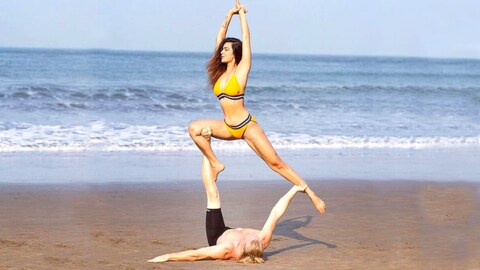5 Easy Ways to Master the Most Popular Yoga Asanas on Instagram
From aesthetic headstands to cute couple poses, celebrity yoga guru Grand Master Akshar shares how you can master these Insta-famous yoga asanas.

Complicated Yoga asanas against a picturesque background are a social media flex that only a few can manage. So, if you are looking to up your Insta game with a photograph like that, here's help.
From working on your fitness levels to improving flexibility, yoga can help you feel and look your best. Celebrity yogapreneur Grand Master Akshar agrees. He says, "Yoga is for all ages. From losing or gaining weight and having healthy hair or skin to improved immunity, mindfulness and more, yoga asanas can help you in various ways. It is important to connect with your body through your breath during your practice as this creates a solid foundation for advanced level asanas.
So, here are his suggestions to master your favourite Insta-famous, aesthetic yoga asanas
Marjari Variation
• Get down on your knees, place palms under shoulders and knees under hips
• Come on your elbows
• Lift up one leg straight behind you
• Fold your second leg and balance on your knee
• Repeat on the other side
Tadasana Variation
• Stand tall with big toes touching and heels together.
• Draw in your abdominals and relax your shoulders down and back.
• Cross your feet and lift heels up
• Bend down and cross hands to place fingertips on opposite heels
Sirshasana (Headstand)
• Begin by assuming Vajrasana
• Place your elbows on the ground
• Your interlocked palms and elbows must form an imaginary equilateral triangle
• Place the crown of your head on the floor in front of your palms
• Your palms should act as a support to the back of your head
• Walk with your toes towards your head until your back straightens
• First lift your right leg up and align it with your upper body
• Use your core strength, balance and lift your left leg up
• Join your legs and point your toes down
• Remain in this position for as long as you are comfortable.
Word of Advice Those having lumbago, neck pain, spondylitis and high blood pressure should not practice this posture.
Rajakapotasana – King Pigeon Pose
• Begin by assuming Adhomukha Swanasana
• Bring your right knee in between your palms
• Push your thighs down and try not to place your pelvis on your right heel
• Ensure that your chest faces forward and does not tilt to one side
• Fold your left leg and hold your left big toe with your left index, middle and thumb fingers
• Rotate your left shoulder and point your left elbow up
• Bring your left foot as close to the crown of your head as possible
• Raise your right arm and try to hold your left foot
• Do not spread your elbows too wide apart
• Hold the posture for a while
• Alternate your leg and repeat the steps mentioned above
Word of Advice
• Refrain from practising this pose if your shoulders, neck, knees or lower back are injured.
Before you get into a handstand, prepare yourself through this practice of Pincha Mayurasana.
Pincha Mayurasana – Peacock Feather Pose
• Begin by placing your elbows and palms on the ground
• Spread them shoulder-width apart and point your fingers forward
• Walk your toes towards your elbows while keeping your legs straight
• Point your pelvis up and focus at a point ahead
• Raise one leg as high as possible
• Shift your bodyweight entirely to your arms and raise the other leg
• Join your legs and point your toes upward
• Align your feet, pelvis and your waist
• Use your core, shoulder and arm muscle strength to maintain balance and remain in the posture for at least 30 seconds
Adho Mukha Vrikasana - Handstand
• Begin by placing your palms on the ground
• Spread your palms shoulder-width apart and your fingers away from each other
• Focus at a point on the floor without straining your neck too much
• Ensure that you do not bend your arms
• Bring your feet closer to your palms
• Press your palms to the floor and shift your body weight to your palms
• Lift one leg as high as possible
• Use your core and back strength to maintain balance as you slowly begin to lift the other leg off the floor
• Join your legs and keep them straight
• Align your arms, spine, waist and legs
• Keep your muscles tightened to maintain balance
• Remain in the posture for at least thirty seconds
Akshar adds, "Mastery of a handstand requires many hours of practice under the guidance of an expert and there are many ways to get into one. Take the support of a wall or a partner in the initial stages of your practice and with time, let go of the external support. Do not practice inversions if you have hypertension, hypotension or other cardiac conditions."